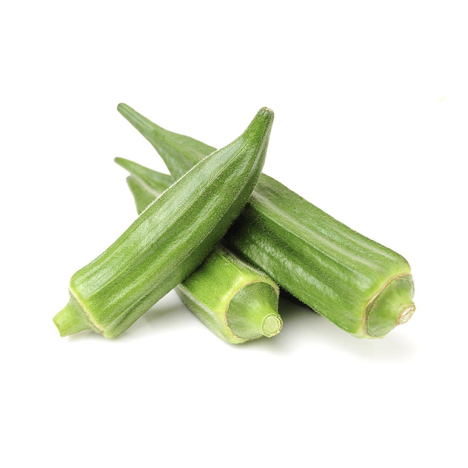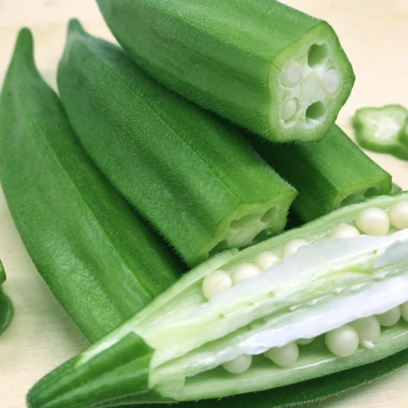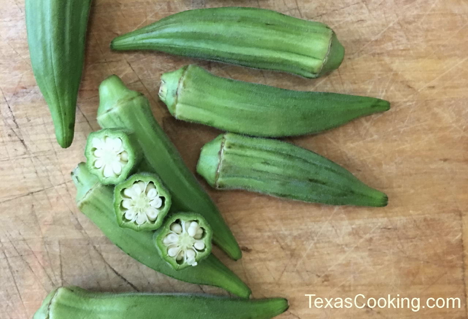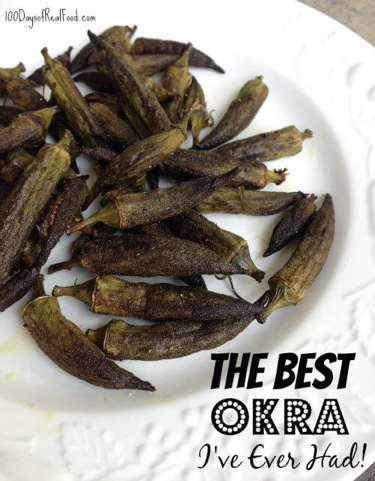Here's to MORE COOKING WITH OKRA!
How many of you cook with okra? I hate to admit it, but I never have. In fact, I’ve never given this food a second thought. But one of our sons, Andrew, was saying how he really likes using it and thought it was odd that I’d never given it a shot. And that spurred some research.

It’s a flowering plant known for its edible seed pods and is sometimes referred to as “lady’s finger.” Okra comes in two colors, red and green. Both varieties taste the same, and the red one turns green when cooked. While scientifically classified as a fruit, it’s typically treated as a vegetable in cooking. We all know it as a key ingredient in gumbo.
It’s not one of the most common foods, which is too bad, because it has an impressive nutrient profile. Consider, for instance, these 7 nutrition and health benefits of okra:

It contains no fat, is a good source of fiber, and is low in calories and HIGH in magnesium, folate, and vitamins A, C, K, and B6.
Okra is antioxidant loaded! Its main antioxidants are polyphenols, including flavonoids and isoquercetin, and vitamins A and C.
Research shows okra helps lower the risk of heart disease. It binds to cholesterol in the gut and lowers blood cholesterol levels. And because it’s rich in polyphenols, it fights harmful inflammation which protects the heart.
Studies also show okra is strong in the anti-cancer department. It contains a protein called lectin, which plays a substantive role in cancer prevention and treatment.

Other research shows okra helps maintain healthy blood sugar levels. It decreases sugar absorption in the digestive tract, leading to a more stable blood sugar response. However, that said, it’s also been found that okra may interfere with Metformin, a common diabetes medication. Therefore, eating okra is not recommended for those taking this drug.
Finally, because of its high folate content, okra is beneficial during pregnancy. Folate is essential in preventing neural tube defects. Just 1 cup (100 grams) provides 15% of a woman’s daily needs for this nutrient.
When shopping for okra, look for smooth and tender green pods without brown spots or dried ends. Store them in the fridge for up to four days before cooking.

Though okra may not be a common kitchen staple, it’s easy to cook. But because it contains mucilage (a thick substance that becomes gummy when heated), it can become slimy. To avoid the slimes, follow these simple cooking techniques:

 Ingredients:
Ingredients:
6 cups whole, fresh okra
3 tablespoons olive oil
salt to taste
pepper to taste
Directions:
Add Recipe to Cook'n
blog comments powered by Disqus

It’s a flowering plant known for its edible seed pods and is sometimes referred to as “lady’s finger.” Okra comes in two colors, red and green. Both varieties taste the same, and the red one turns green when cooked. While scientifically classified as a fruit, it’s typically treated as a vegetable in cooking. We all know it as a key ingredient in gumbo.
It’s not one of the most common foods, which is too bad, because it has an impressive nutrient profile. Consider, for instance, these 7 nutrition and health benefits of okra:

It contains no fat, is a good source of fiber, and is low in calories and HIGH in magnesium, folate, and vitamins A, C, K, and B6.
Okra is antioxidant loaded! Its main antioxidants are polyphenols, including flavonoids and isoquercetin, and vitamins A and C.
Research shows okra helps lower the risk of heart disease. It binds to cholesterol in the gut and lowers blood cholesterol levels. And because it’s rich in polyphenols, it fights harmful inflammation which protects the heart.
Studies also show okra is strong in the anti-cancer department. It contains a protein called lectin, which plays a substantive role in cancer prevention and treatment.

Other research shows okra helps maintain healthy blood sugar levels. It decreases sugar absorption in the digestive tract, leading to a more stable blood sugar response. However, that said, it’s also been found that okra may interfere with Metformin, a common diabetes medication. Therefore, eating okra is not recommended for those taking this drug.
Finally, because of its high folate content, okra is beneficial during pregnancy. Folate is essential in preventing neural tube defects. Just 1 cup (100 grams) provides 15% of a woman’s daily needs for this nutrient.
When shopping for okra, look for smooth and tender green pods without brown spots or dried ends. Store them in the fridge for up to four days before cooking.

Though okra may not be a common kitchen staple, it’s easy to cook. But because it contains mucilage (a thick substance that becomes gummy when heated), it can become slimy. To avoid the slimes, follow these simple cooking techniques:
- Cook at high heat.
- Avoid crowding your pan or skillet, as this will reduce the heat and cause sliminess.
- Cooking it in an acid-like tomato sauce reduces the gumminess.
- Simply slice and roast okra in your oven.
- Grill it until it’s slightly charred.

Roasted Okra
6 cups whole, fresh okra
3 tablespoons olive oil
salt to taste
pepper to taste
Directions:
1. Preheat oven to 425 degrees F.
2. Spread okra on a baking sheet and toss with olive oil, salt, and black pepper.
3. Bake just under the top rack of the oven for approximately 40 – 45 minutes.
4. Stir with a spatula after 20 minutes and every 10 minutes after that until it begins to turn dark brown and crispy, but not burnt.
5. Serve warm or at room temperature.
2. Spread okra on a baking sheet and toss with olive oil, salt, and black pepper.
3. Bake just under the top rack of the oven for approximately 40 – 45 minutes.
4. Stir with a spatula after 20 minutes and every 10 minutes after that until it begins to turn dark brown and crispy, but not burnt.
5. Serve warm or at room temperature.
Recipe formatted with the Cook'n Recipe Software from DVO Enterprises.
Sources:
- www.bjs.com
- www.alibaba.com
- www.texascooking.com
- www.foodsafetynews.com
- www.100daysofrealfood.com
 Alice Osborne
Alice Osborne
Weekly Newsletter Contributor since 2006
Email the author! alice@dvo.com
